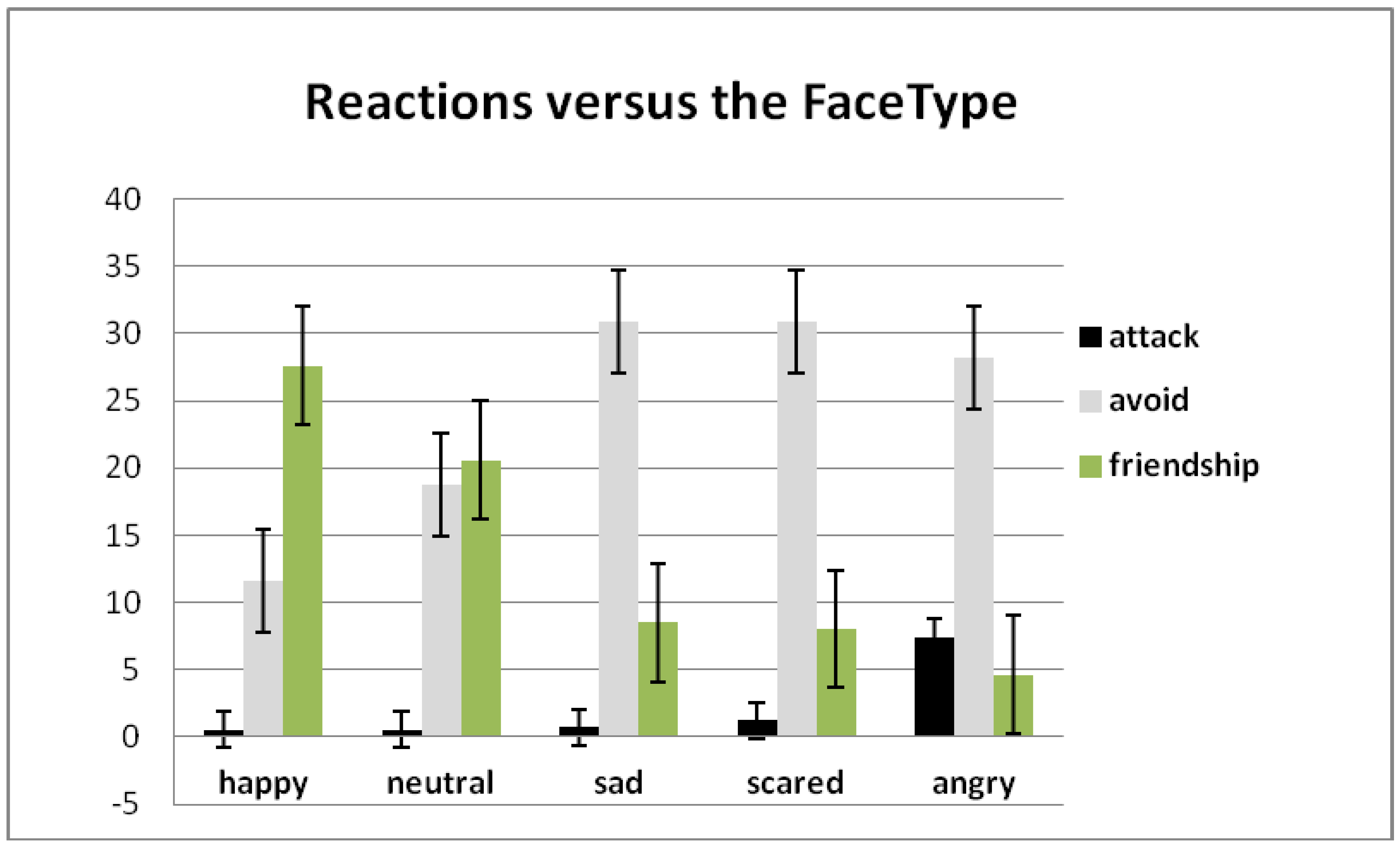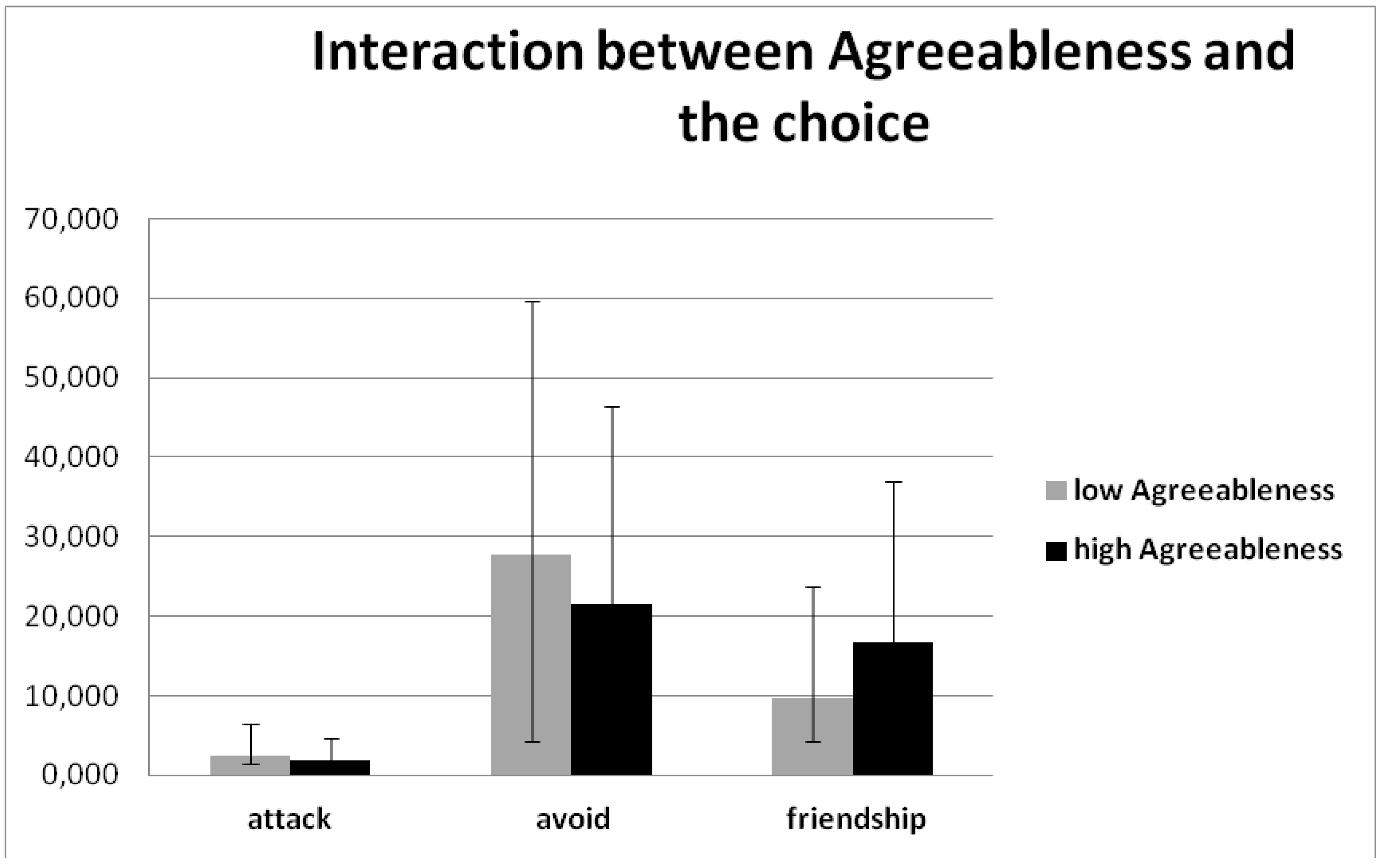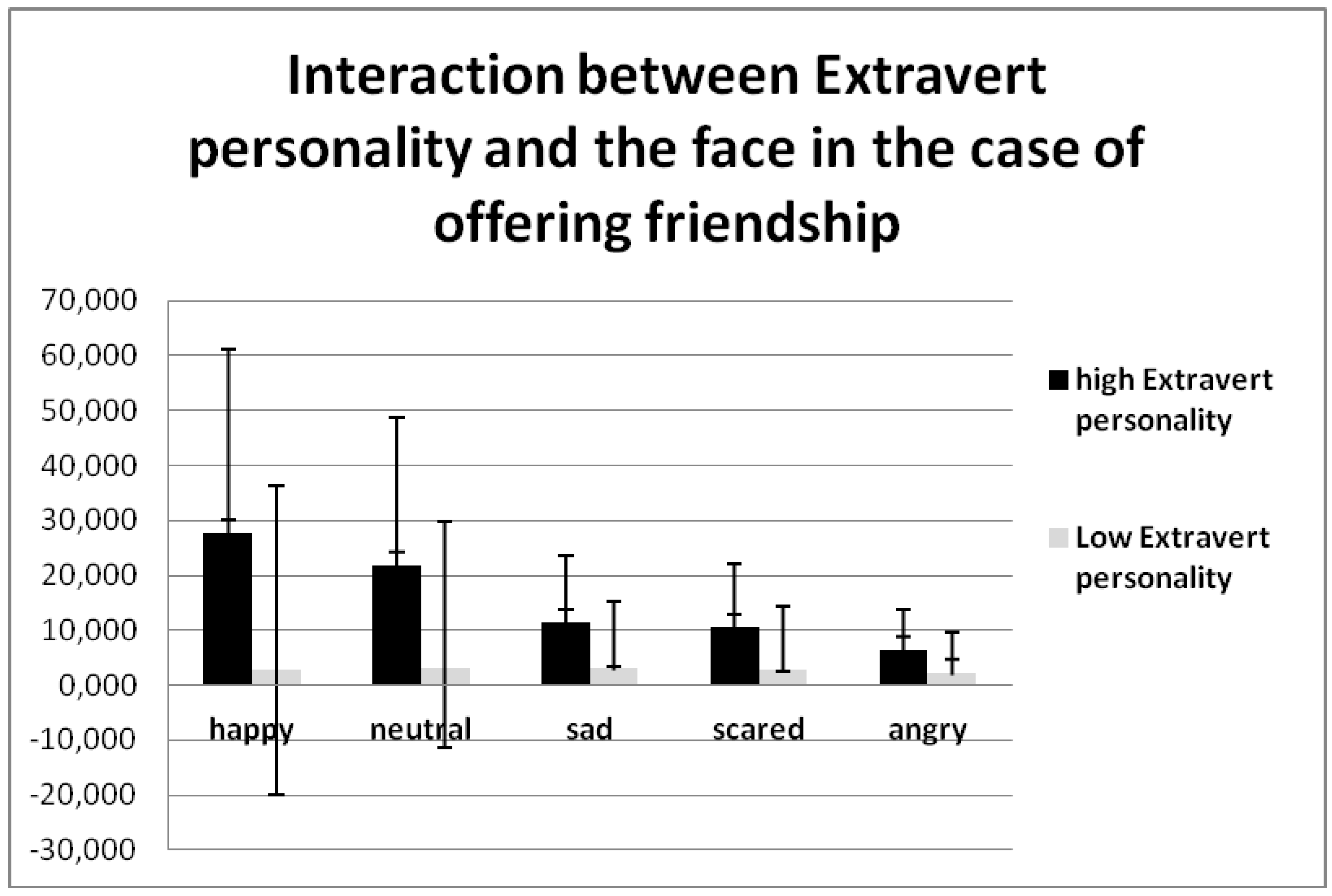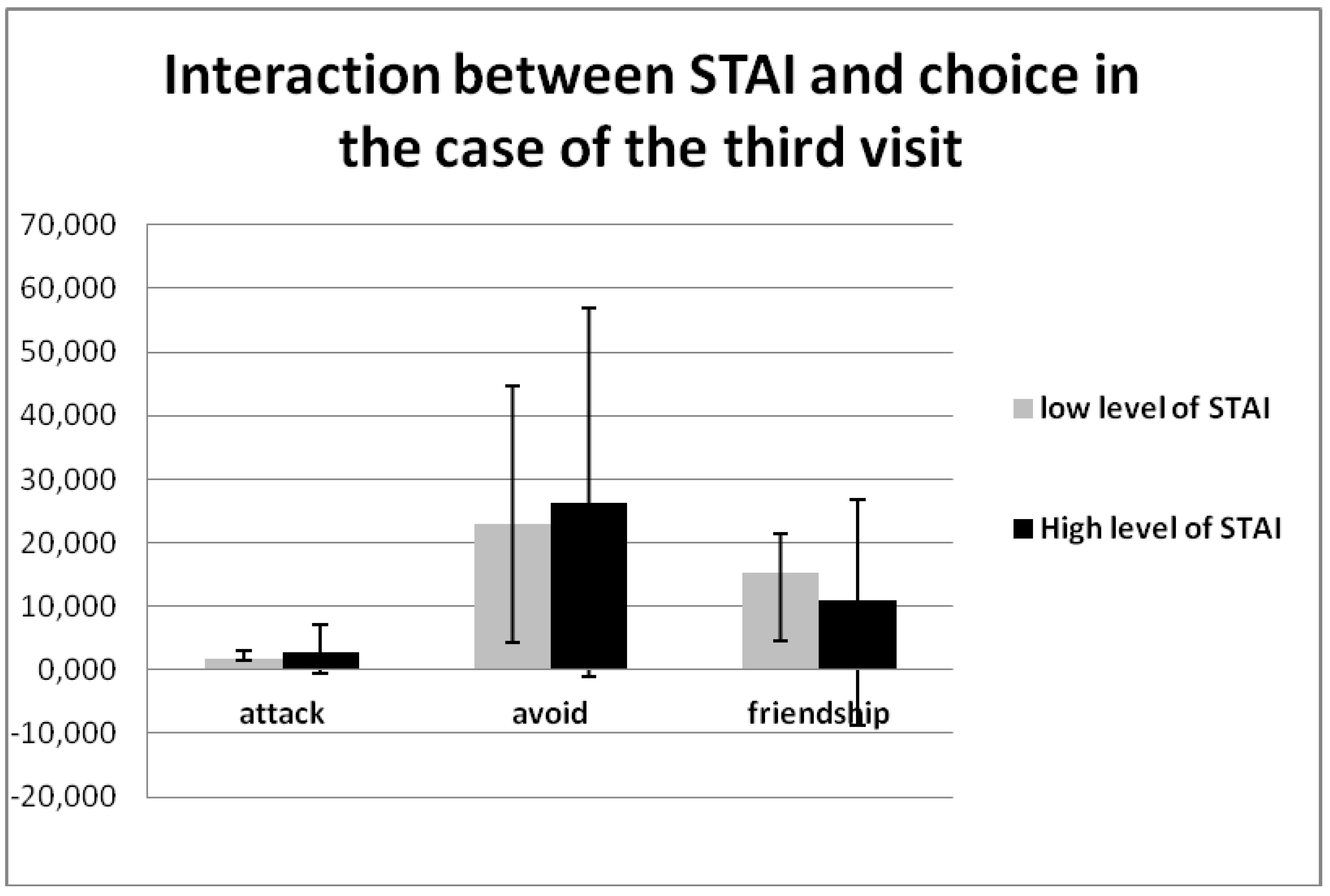1. Introduction
Since human beings are known as “social animals”, social interactions are extremely important for a successful life. Cultural psychology and social neuroscience are constantly developing as independent disciplines, but it is important to understand the fact that various types of social statuses influence social interaction [
1].
We all grow up, develop, and reveal ourselves in society. In connection with this, the investigation of human interactions is of great interest. The main limitation is the unexpected nature of human interaction. In this light, we need a well-controlled stimulus that makes it possible to minimize this difficulty in the experimental procedure. This work presents a model of social interaction. Hopefully, this model will assist in the investigation of behavioral reactions during virtual social interactions.
Social interaction depends on signals in different modalities. However, it is well known that facial expressions play a critical part in social interactions [
2,
3,
4,
5] because they are connected with emotions, a considerable factor in the decision making process, which is important before choosing a response [
6,
7]. Facial expressions of an emotion convey not only the internal state of the subject, but also convey interpersonal information, which is the predictor of social interaction [
8]. The possibility of recognizing the feelings and attitude of other people is a critical factor in successful human interactions. The absence of this skill could lead to inappropriate social behavior.
To study the connections between individual characteristics and subject responses we used the Five Factor Model (FFM) of personality [
9,
10,
11]. The Five Factor Model (FFM, Big Five personal characteristics) of personality includes five traits taken from the factor-analytic studies based on people’s descriptions of themselves and other people [
12]. The FFM consists of five qualities: (1) Extraversion, defined as kind, sympathetic, friendly, and warm; (2) Conscientiousness, defined as dependable, reliable, thorough, and careful; (3) Openness to Experience, defined as artistic, creative, imaginative, and cultured; (4) Agreeableness, defined as friendliness, ability to come to an agreement, compassionate, and cooperative; and (5) Neuroticism, defined as anger, anxiety, depression, and vulnerability, with the opposite pole being emotional stability [
13,
14].
The question why different people manifest different kinds of behavior is the core problem of theories of personality [
15]. Eysenck, Wilson, and Jackson [
16] assumed that there are only three strategies in solving interpersonal problems. These three strategies are the following: Aggression and hostility, fear and flight, and social interaction. They suggested that these types of behavior are reflected in personality dimensions of psychoticism, neuroticism, and extraversion, respectively [
17,
18,
19].
J.A. Gray’s theory [
20,
21,
22] has two dimensions of personality; namely, anxiety and impulsivity. These personality features formed the basis for the conception of the Reinforcement Sensitivity Theory [
23]. It contains two neurological systems, which are responsible for the reaction to environmental stimuli.
The behavioral inhibition system (BIS) is linked with an aversive motivational system. It is sensitive to punishment stimuli and responsible for the inhibition of behavior in risky situations. BIS is proposed to be a psychophysiological foundation (basis) of anxiety. The behavioral award system (BAS) is sensitive to reward stimuli and regulates reward-seeking behavior. BAS is assumed to be the basis of impulsivity [
23]. The excessive activity of these systems is connected with psychopathological manifestations [
24].
BIS is responsible for passive avoidance and has a weak role in active avoidance [
25]. Gray considered that BIS is responsible for the experience of negative feelings such as fear, anxiety, frustration, and sadness in response to cues [
26,
27,
28], and BAS is responsible for the experience of positive feelings such as hope, elation, and happiness [
27,
28].
A.J. Elliot and T.M. Thrash [
29] were exploring the relationship between such important building blocks of personality as extraversion, neuroticism, BAS, and BIS, and came to the conclusion that these different features possess a common foundation of an approach and avoidance temperament. Approach and avoidance is a pair of concepts which refers to two basic orientations toward stressful information, or two basic modes of coping with stress [
30].
Based on the above data we developed an experimental model, which is simplified to some extent, but on the other hand is a well-controlled task. In this study, we used a modified experimental model of virtual social interactions previously published in the study of Knyazev et al. [
31]. Photos with emotional facial expressions, which contain angry, fearful, sad, happy, and neutral faces, were presented to participants. There are three types of social behavior that were offered in response: Friendly, avoiding, or attacking. A number of psychological questionnaires were requested to be filled out.
It is very important for researchers, especially in the fields of medicine and neurophysiology, to orient themselves concerning the issues of data reproducibility quality control, since false conclusions based on inappropriate methods of analysis lead not only to a waste of time for testing false hypotheses, but also to make threats to people’s health in the future.
An important parameter for determining the quality of a medical instrument is agreement with a reference point. Various statistical methods have been used to test for agreement. Agreement signifies the accuracy of that particular instrument [
32]. The study in Reference [
33] reviewed almost all statistical methods used to assess agreement of medical instruments measuring the same continuous variable in the medical literature. Some of these methods have been shown to be inappropriate: The Bland–Altman method [
34], the correlation coefficient [
35], coefficient of determination [
36], paired
t-test [
37], regression coefficient [
38], and Gradient-Based Algorithms for On-Line Regression [
39] are all questionable [
33].
All details about the correlation coefficient and coefficient of determination are described in the following book [
40].
For our study we have chosen to use the ICC method. The main disadvantage of this method, that it is influenced by the range of data, is not the case with our data, which is why we have chosen it. If the variance between subjects is high, the value of the ICC will certainly appear to be high, and in our case the variance between subjects is sufficient. The use of ICC in assessing agreement has been criticized by Bland and Altman, who assert that the ICC ignores ordering, and treat the ICC method as a random sample from a population of methods [
41].
Accurate reproducibility of the original data-repeatability or test–retest reliability [
42] is the basis of professional scientific research [
43], and this is generally recognized by the scientific community. Quality verification of the reproducibility of the original data is a standard section in scientific publications related to the statistical processing of experiments, and it is usual that the number of experiments should be no less than three within a 2–3 week interval [
44].
As an absolute, the standard error of measurement (SEM) and smallest real difference (SRD) are used, which is equivalent to what is known as the “reliable change index” in psychotherapy research [
45].
In this study we aimed to test two hypotheses:
Hypothesis 1. The experimental scheme and the chosen time interval between the measurements provide data with a sufficient level of reliability.
Hypothesis 2. The model of social interaction that is a result of personal characteristics from questionnaires makes it possible to measure the real life parameters of behavior, such as attacking, avoiding, or friendly behavior. In the first approximation we can suggest that extraverts, as people with a lot of positive emotions, should offer friendship more often; aggressive people should be connected with attacking reactions; and anxious people should prefer avoiding behavior.
4. Discussion
The main aim of this study was to define the connections between the personality parameters of people in tests and their reactions to facial expressions presented to them.
We considered the connection between the reaction of the subject generated by different facial expressions according to the theory of Eysenk, and have received significant results with such parameters as agreeableness, collectivism, emotional intelligence, RISC, extrovertism, STAI, anger, and neuroticism, and the reaction types (attacking, avoiding, and friendly), which is further proof that the individual characteristics of a person predict social behavior. These results are consistent with the extension of the neural efficiency concept for personality [
45], and it complies with many works listed below.
Another goal of this study was to check the test–retest reliability connected with repeatability of the experiments, and it was found that it is almost perfect. This means that the more reliable the received results are, the more probable the predictions are.
The personality quality of agreeableness makes people think that this quality is the key quality for proactive behavior, and the results of another study of this laboratory confirms this feature as well [
52]. In this relation we can affirm that agreeableness is a personality factor which undoubtedly predicts interpersonal deviations. Agreeableness is related to friendly altruistic behavior and avoiding competition, anger, egocentrism, and jealousy [
53,
54,
55,
56], and it is connected with social-cognitive Theory of Mind [
57].
Research on the “Big Five” personal characteristics and aggressive behavior has discovered that people with low agreeableness are more aggressive and violent [
58]. In the results it can be seen that people with low agreeableness like to attack more frequently than people with high agreeableness, and they attack aggressive faces least of all.
Agreeableness is related to cooperativity [
59,
60], and our results demonstrate that people with high agreeableness have a greater desire to make friends, and less wish to attack and avoid other people. That is, they try to fit in with the collective and to organize groups and friendly interaction, which means cooperativity.
Overall, individuals unconsciously use impressions and clues to predict to which extent they can trust the interaction partner and to behave correspondingly [
61,
62,
63]. Being naturally inclined to cooperation, agreeable individuals are willing and able to do that. It is suggested that the propensity to delve into the mental states of other people seems to be central to agreeableness [
57]. Highly agreeable people obviously tend to make decisions based on emotions more quickly in contrast with less agreeable people [
64].
At the beginning of this article we made a hypothesis about the extravert personality and our results confirmed it. Optimistic people have high extravertism in their personality [
65] and a positive affect association [
66]; that is why they offer friendship more often and avoid others less often than people who are the opposite.
We can also combine STAI and neuroticism, though they have the same effect. Our results with the quality of anger have the opposite effect in comparison with neuroticism. Anger is inversely related to neuroticism [
67]. STAI and anger qualities are very important characteristics in the diagnosis of clinical disorders, and these parameters are connected with the emotional condition of individuals, which can be the reason for the reaction [
68].
According to the article of Reference [
69], anxiety and aggressiveness may predispose one to exaggerate hostile intentions in other people. This may have an impact on everyday interpersonal relationships, as our results demonstrate; that is, people with a high neurotic level avoid other people more often, and less often offer friendship.
Extraversion, neuroticism, and agreeableness predicted measures of friendship quality. Therefore, our results allow us to conclude that variations in affectivity are significant predictors of qualitative aspects of people’s social relationships [
70].
The next personality trait, that of collectivism, is interesting to view and compare in different cultures. For example, in some studies [
71] it can be seen that there is no definite differences between Japanese and USA cultures, but there are significant differences in the personal characteristics of individualistic-collectivistic groups in brain activities [
72,
73,
74,
75]. It is remarkable that in our investigations we have found significant differences between the collectivist trait and reaction, and moreover, people with a low level of the collectivist trait attack aggressive people more often. This theme of collectivism-individualism is also described using details of anatomic structure in fMRI research [
76]. Incidentally, people with the collectivist trait need less time to transition to another state, and the dynamic of emotions is higher in such people than in the group of people with the opposite trait [
77,
78].
The results of this study demonstrate that people with high RISC qualities offer friendship more often, they are more communicative, and suggest being friendly with every type of face more than those low in RISC. They report more relationship supportive behaviors, experience greater fulfillment of friendship functions, and report higher relationship quality [
79]. They are related to more positive evaluations of the relationship [
80] than individuals low in RISC.
The last quality we would like to consider is the STAI. Our results are in accordance with the hypothesis that personal characteristics, such as anger, rather accurately describe the reaction of the person. The Five Factor personality test significantly predicts the trait of anger and anger expression styles (anger-in, anger-out, and anger control) [
81]. Furthermore, people with high STAI avoid others and offer friendship less frequently, because they really do not know what to expect from others, and are probably afraid of others forming a wrong opinion of them, because such people have the wrong feedback [
82].















